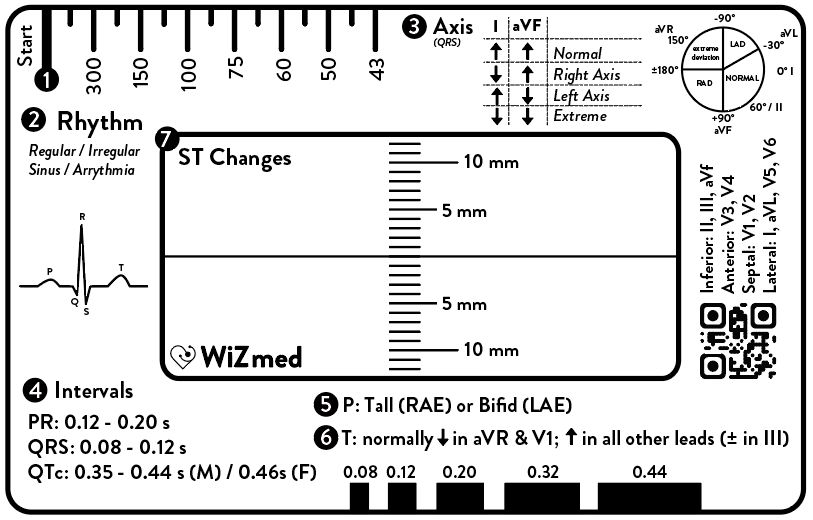
WiZmed 7-Step ECG Ruler
Your Step-by-Step Approach toReading ECGs Confidently
In healthcare, having an approach is everything. Whether it's chest pain, shortness of breath, or dizziness—there's a structured way to tackle it. The WiZmed ECG Ruler gives you that same structured approach for ECGs—so you never miss a beat.
What's on the Card?

The 7-Step Approach to Reading Any ECG
Follow these steps systematically to never miss important findings
Rate
Use the top ruler (300-43) to estimate heart rate. Line it up with the R waves—quick and accurate.
💡 Tip: 1 large box = 300 bpm, 2 boxes = 150 bpm, 3 = 100 bpm…
Rhythm
Ask: is the rhythm regular or irregular? Is there a P wave before every QRS?
💡 Tip: Sinus or not? Any dropped beats?
Axis (QRS Axis)
Use the axis quadrant visual to determine normal axis, left/right axis deviation, or extreme axis deviation.
💡 Tip: Line up leads I and aVF, and apply the quadrant rule.
P Waves
Are the P waves tall, peaked, or bifid? This helps identify right or left atrial enlargement.
💡 Tip: Use the diagram for comparison.
T Waves
Check T wave direction: Normally inverted in aVR and V1, upright in other leads.
💡 Tip: T-wave inversions can signal ischemia, electrolyte issues, or more.
Intervals
Use the built-in scale to measure PR (0.12–0.20s), QRS (0.08–0.12s), QTc intervals.
💡 Tip: This helps pick up conduction delays, blocks, and prolonged QT.
ST Segment
Use the ST elevation box to assess for STEMI, pericarditis, or ischemia.
💡 Tip: Compare against the 1 mm and 2 mm markings to assess quickly and accurately.
Who Is This For?
Medical Students
Perfect for learning ECG interpretation and exam preparation
Interns & Community Service Doctors
Essential pocket reference for on-call situations
Paramedics & Nurses
Quick reference tool for emergency care situations
Anyone Who's Panicked During ECG Exams
Build confidence with a structured, systematic approach
Learn by Watching
Walk through all 7 steps in under 2 minutes
Watch Demo Video
Click to watch the complete walkthrough
WiZmed 7-Step ECG Ruler
A pocket-friendly ECG ruler & reference card designed by medical students and clinicians for fast, systematic interpretation. Follow the 7-step approach—Rate, Rhythm, Axis, P Waves, T Waves, Intervals, ST Segment—so you never miss a beat on the ward, in the EC, or during exams.
Meet the WiZmed ECG Card: a durable, wipe-clean quick-reference tool that puts rate calculation, axis quadrant, ST-segment mm box, and interval ranges right in your hand—plus a QR code to our step-by-step tutorial.
Read Any ECG in 7 Steps
1) Rate
Use the top ruler (300–43) to estimate heart rate by aligning consecutive R waves.
Tip: 1 large box ≈ 300 bpm, 2 ≈ 150, 3 ≈ 100…
2) Rhythm
Regular or irregular? Is there a P before every QRS and a QRS after every P?
Sinus or not; any dropped beats?
3) Axis
Use the quadrant visual to identify normal, left/right axis deviation, or extreme axis.
Line up leads I and aVF to apply the quadrant rule.
4) P Waves
Check for tall, peaked, or bifid P waves to screen for atrial enlargement.
5) T Waves
Confirm expected polarity (inverted in aVR & V1; upright elsewhere) and look for inversions.
6) Intervals
Use the scale to measure PR (0.12–0.20 s), QRS (0.08–0.12 s), and assess QT/QTc.
7) ST Segment
Use the ST mm box to gauge elevation/depression for STEMI, ischemia, or pericarditis.
Quickly compare to 1 mm and 2 mm markings.
Built for Speed, Designed to Last
Pocket-Ready & Durable
Thin, sturdy, and wipe-clean—made to live in your scrub pocket and survive call.
Calibrated for Clinical Use
Designed for standard 25 mm/s paper speed and 10 mm/mV gain.
Learn Faster with QR
Scan the QR to access our interactive tutorial page and demos.
Made for SA Healthcare
Designed in South Africa 🇿🇦 by medical students, interns, and doctors.
Who Is It For?
Medical Students
Learn ECGs with a repeatable framework.
Interns & Community Service
On-call confidence for rapid decisions.
Paramedics & Nurses
Quick, practical reference in emergencies.
Exam Prep
Structured approach that reduces panic and guesswork.
What's on the Card?
- Rate scale (300, 150, 100, 75, 60, 50, 43)
- Rhythm assessment checklist
- Axis quadrant tool (I & aVF)
- P-wave and T-wave interpretation cues
- ST-segment elevation/depression mm box
- Interval reference ranges (PR, QRS, QT/QTc)
- QR code linking to the tutorial and demos
Technical Specifications
Helpful Resources
Learn the method in detail and practice with examples:
Note: This card is a clinical reference aid and does not replace clinical judgement or institutional protocols.



